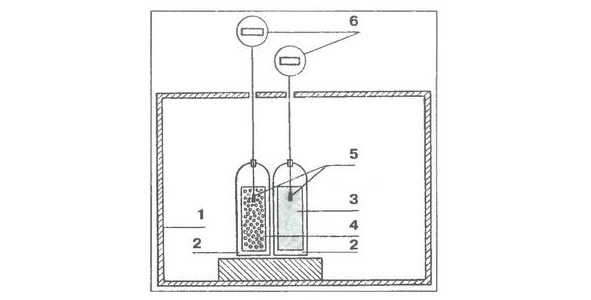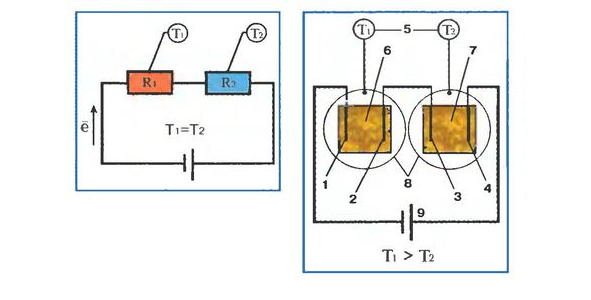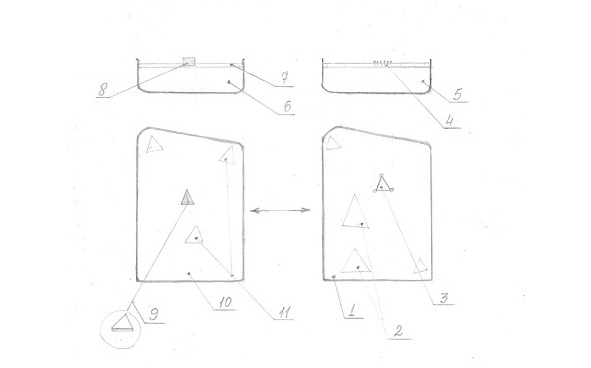
…How to collect scattered in space, as if already asleep energy? Obviously, there are natural natural processes that increase its quality to its original value.
These are not some complicated devices. Everything happens by itself. You just need to be able to see.
The hot kettle on the table gives energy to the space – the table, the streams of air, etc. With the passage of time it cools down. The motion of molecules is evenly distributed in the environment. The energy of high order disappeared, replaced by a uniform thermal background. Is it possible to reverse the process? Will the impulses from the environment of the teapot be transferred in a particular case, will it boil right on your kitchen table?
This is how it should be if in nature, from the beginning of time, there is a cycle of energy.
One of the author’s first publications on this topic is an article in “TM”, No. 4, 2000:
“What is the difference between an object of the macrocosm — a monolith — from a cloud of dust obtained as a result of its long grinding and subsequent shaking? Well-known: the area of contact with the environment of another phase, for example, with gas. That is why the chemical reactions that occur in powders are completely unaffected by monoliths, iron filings burn in the air, whereas an iron nail, except in pure oxygen…
Dusty laser?
But the question is: what happens when the monolith is grinded or, conversely, how does the dust coalesce again into a monolith with a radiation-absorption spectrum? Let’s help the laws of quantum physics.
In monolith, the spectrum runs through all the energy levels, theoretically, as many as the atoms in the body. In a gas, individual atoms radiate independently, on a few levels. But when the neighboring atoms appear, the levels shift so as not to repeat each other, the prohibition principle introduced at the beginning of the 20th century works. Wolfgang Pauli: there can not be interconnected atoms, the energy parameters of which are completely the same.
But the powder is an intermediate state between the gas and the solid. Apparently, a sharp boundary, on which the properties change spasmodically, can not be carried out. And accordingly, the spectrum of the dust cloud, as the particles are fragmented, will approach the gas spectrum.
But what happens if you thicken it to the volume of the original monolith?
When merging, say, a hundred particles, each energy level will take at once one hundred atoms. To restore the order adopted in the microcosm, each of these supersaturated levels will tend to split into a hundred isolated spectral lines. The most natural way to restore the energy hierarchy for atoms of a newly formed monolith is to radiate a certain number of electromagnetic quanta. Consequently, the condensed cloud of dust will become generally colder than the surrounding environment.
Are we humans the same hubs? Than our cells are not isolated “motes” separated by membranes? But the permeability of membranes is constantly changing. And are there many unrelated properties of living organisms that are not associated with such a unification of many millions of “dust particles”?”
Continuation – in the article “Energy concentrators”, “TM” No. 6, 2002, already based on practical, not mental experiments.

1. cabinet with thermal insulation
2. Dewar vessels
3. continuous medium (water)
4. porous medium
5. electronic thermometers (error not more than 0,02С)
6. temperature sensors
Two vessels – one with a porous medium, the other – with a solid, are located in a thermally insulated cabinet. They have thermal sensors; the temperature inside is measured every 20 minutes.
It was found out that the temperature in a container with a granulated medium (wet sand, etc.) varies abruptly, with considerable amplitude. The solid medium gives a very flat temperature graph, without bursts and any periodicity.
Porous, granular, otherwise – ordered matter has the property of ordering – to collect in space and time, energy. Probably, this property manifests itself on different scales. Local heating can also occur in a handful of sand, earth, porous clay, only one or two degrees, and in large areas, in square kilometers. The temperature can increase by tens, hundreds of degrees, possibly accompanied by radioactive emissions. So the energy of a high level comes back to the world.
In a certain way ordering matter, it is possible to achieve a predictable ejection of heat (or cold), in certain areas of the created system. Covered by feedback, the system creates a “cold-heat” pulsation; from this one can obtain a steady stream of energy. The ordering can be performed on macroscopic (fractions of a millimeter) and micro-levels (the distance between the atoms of the crystal). In the latter case, it is possible to achieve not intermittent flicker, “eternal radiance”.
In the first approximation, the concentration system looks like the organization of flows of a homogeneous, initially disconnected substance to some common point, a kind of “heart” with subsequent separation.
Some successes in this, perhaps even intuitively realizing the essence of the process, were achieved by American researchers Fleischman and Pons. They are known to conduct electrolysis of heavy water on palladium electrodes. Their idea – the molecules of the hydrogen isotope accumulate in the crystal lattice of the metal, as closely as possible – and interact. As a result of the “cold nuclear fusion” (NNS), an anomalous heat release occurred (four times higher than the calculated one), but, in addition, there was no neutron radiation associated with it.
In the end, experiments – although they were reproduced in other laboratories, were abandoned, they were almost forgotten. But, with a satisfactory theory: “A structured substance structures energy, creates an order around itself,” they can be revived, put on an appropriate, correct pattern. Hydrogen atoms were collected in one small volume, and therefore they were forced to radiate (relatively soft) photons from their upper energy levels. Isotopes, the synthesis of light nuclei, radiation – this can be forgotten. New reactors of Eternal Motors are loaded with any, not radioactive, but – structured substance.
Note: A structured body (massif) is a cluster of clusters (dust grains) of a substance of equal shape, composition that is some distance from each other in a semitransparent medium or a vacuum. An additional structure in time, give periodic rendezvous and separation of particles – which is like breathing or pulse.
The author reproduced the experiments of Fleischmann and Pons at home, replacing heavy water with ordinary tap water, and palladium electrodes with sand.
It turned out this article:
Electrons get tired?
“Some of the fundamental laws of physics are so simple and obvious that no one doubts their justice, and no one is involved in their verification. In particular, this applies to Ohm’s law, according to which the direct current in the circuit (in any case at its low density) is equal to the voltage divided by the resistance: I = U / R. This is followed by other rules of electrical engineering. For example, according to the Joule-Lentz law, the heat W allocated to the resistance R is directly proportional to the voltage drop across it U, the current I and the duration of its passage t, that is, W = R-U-1-t. Therefore, if two identical resistances are sequentially included in a closed circuit, then the same amount of heat should be allocated to them in a unit of time. It seems quite obvious that, bypassing the first resistance, the electrons are not able to either acquire additional energy or lose it.
But does Ohm’s law really hold for resistances of all kinds at low current densities? Interested in this issue, I performed a series of simple experiments. Two, if possible, the same resistance, I included in the DC circuit, and next to them attached sensors sensitive thermometers. Each resistance, together with its “own” sensor, was placed in a separate thermostat.
In the first experiments, as resistance, I used incandescent lamps (calculated for a voltage of 2.5 V and a current of 0.15 A). Turning on the current (its source was a reducing stabilizing transformer and a rectifier included in a household circuit with a voltage of 220 V), I measured the temperature in thermostats for an hour; then changed the lamps in places and repeated the measurements. Five series of similar experiments showed that the metallic resistances gave off the amount of heat in full accordance with the classical laws of electrical engineering, and no matter where these resistances were located.
I did not make measurements using resistances of other types, but I performed the experiment using electrolytic cells as a resistance in which ordinary tap water was decomposed on stainless steel electrodes; the result again did not reveal any anomalies.
But if electrolysis of water was carried out in a porous, heterogeneous medium, the picture turned out to be different.
I filled the electrolytic cells with a mixture of quartz sand and tap water, acidified for better electrical conductivity by several drops of hydrochloric acid (which, generally speaking, is not necessary). And the first experiments gave amazing results, not corresponding to the classical laws of electrical engineering.
Namely, the temperature in the thermostat located in the course of the motion of the electrons turned out to be much higher than the temperature in the next thermostat! At a voltage of a current source of 220 V and its strength of 0.5 A, the difference was 90°C, which significantly exceeded the error value of previous experiments. In total I performed 10 similar experiments and noticed that the difference in temperature between cells clearly depends on the current strength in the circuit and can reach even a few tens of degrees.
I also noticed that on the first cell the voltage drop was higher than the second one (150 and 70 V, respectively), which explains the increased heat release. But the main question remained without an answer: why is there such a noticeable asymmetry, if before and after the experiments the resistance of the cells were the same? After all, this effect should not be!
It can be assumed that in the first cell the electrons for some reason lose some of their internal energy and therefore in the second cell they are no longer able to interact with ions as intensively. But in fact the second cell too (though not style strongly) heats up. True, in the sand-water electrolytic cells there are many local and rather sharp differences in the resistance of the medium, as a result of which the electrons in it are sharply accelerated, then they are sharply slowed down. Is not this the reason for the effect that I observed?
Of course, my assumption that after passing a certain device, the electrons can seem to get tired, giving the environment some special energy, contradicts the laws of nuclear physics, according to which the electron does not have an internal structure and has only a reserve of external kinetic energy. But if I’m wrong, then let me point out the error, preferably by repeating my experiments.

1—4. electrodes made of stainless steel
5. thermometer sensors
6. The first sand-water cell
7. The second sand-water cell
8. Thermostats
9. DC power supply
…The original idea of the experiment is an anomalous heat release in a granular medium. It turned out not quite what was supposed to be found, but still, the result is interesting. It looks as if the charge carrier, ions and electrons, interacting tightly with each other in the first cell along the current, lose some of their internal energy. And, of course, all this happens in an internally divided, more or less ordered environment.
Unfortunately, the lack of calorimeters, tools for accurate determination of the amount of heat released do not allow to receive data at a quantitative level. But the qualitative result is also a good result.
In the first approximation, the generator of electromagnetic energy can look like a slurry of magnetic microscopic balls in an external medium. According to all the above, the ordered array should periodically change its properties (and hence the magnetic flux) in time. It remains to add to it a coil with a wire to get a more or less perpetual generator.
In the case of a teapot, things are as follows. Let the table on which it is left to cool – a highly ordered structure of many identical elements, in a closed volume (it can be large). The energy of boiling water is first distributed throughout the volume. Then, macroscopic temperature fluctuations will arise in the system. The period of their appearance in this or that place can be calculated or even organized. We put the cooled vessel at the right time in the right place – and it boils.
This structure can work in an open space, attracting the energy scattered in the medium, raising it to the previous high level.
To such systems, undoubtedly, one can class living beings, beginning with the simplest unicellular ones. The body consists of billions, trillions of pores, membranes opening and closing according to a certain rhythm. For its life, it attracts more energy than it consumes when digesting food, which is proved by some scientific studies. Obviously, living, ordered matter is a kind of perpetual motion machine – however, not quite perfect yet. At the very least, food is needed for metabolism, cell replacement, and the like.
High orderliness is possessed by forest massifs, crops of crops, ice cover, possibly, deserts and dried salt lakes. Here, first of all, it is necessary to look for anomalous heat releases, and even radiation.
The energy (thermal, electromagnetic) that passes through the massif of matter evenly brings order into it. A standard example is the Benard cells, hexagonal honeycombs emerging in the oil layer on the heated surface. Thus, systems reanimating energy can be created, including a melt, from a solidification, under conditions of thermal energy inhomogeneity.
Interaction of similar forms
It is intuitively clear that two identical objects are linked in some way; Further on this inner conviction layered the well-known physical formulas and principles.
Any physical body has a strictly set of levels of absorption-radiation of electromagnetic waves. The location of the energy bars is affected by the structure, shape, chemical composition, temperature, etc. In other words, the spectrum, in its entirety, is the name of the thing, the set of drawings, the code.
What will happen if, in a closed volume, two identical things are located next to each other? They will start exchanging radiation. The system will tend to come to a stable equilibrium. This is possible when the lines of the spectra of both bodies coincide.
In other words, the spectrum of the body A will tend to impose itself on the body B, and vice versa. Electromagnetic radiation is not purely informational, it has a certain power component. If the bodies A and B (at least one of them) are sufficiently plastic, they will tend to change – in the direction of maximum mutual similarity.
Here, presumably, at a macroscopic level, Pauli’s principle (prohibition) can come into force – two objects can not be (nearby, in the same system) at a single energy level. Thus, around the body A there are concentric zones in which its action on B will be destructive, or creative. The likeness of A and B depends on exactly how far apart they are separated. It is possible to determine this distance only empirically (ie, experimentally).
We will refer to the act of additional assimilation by exchanging our own radiations – Synchronization. As a result, we get two physical bodies, each of which has microparticles having their reflection, a synchronized pair, in another object. And, these particles interact by exchanging electromagnetic quanta (and, perhaps, somehow in some other way).
Here, the Heisenberg uncertainty relation (principle) comes into play. Roughly speaking, two microparticles in a relatively small region, having the same parameters, become paradoxically connected in some way. Some changes in the particle A are transmitted to the partner B, instantly, and, as the founders of quantum mechanics claim, in a non-physical way (ie, without the participation of any waves or particles). A and B are considered as a single system, even if the parts are in different parts of the universe.
It turns out, after the primary synchronization, the macroscopic bodies A and B, made up of myriads of microscopic a and b, feel each other’s changes. There are various schools of quantum mechanics, some of them try to observe the principles of the Theory of Relativity (the finiteness of the speed of light). But it seems that we have a communication system in which the signals are transmitted many times higher than the “constant” C (300 000 km s).
In the first experiments, I used two identical containers A and B. In the first I put a simple small addition – a figure of a triangle, a square, a pentagon … In both tanks I poured a hot solution of hyposulfite, placed them side by side in a thermally insulated box, and waited for the crystals to show. The solidifying solution is the desired plastic body, sensitive to internal and external influences.
In many cases, the crystals actually appeared on the surface of the solution, formed a kind of label. But, with each time such experiments were reproduced worse and worse, coming to naught usually, to the fourth repetition. This is not quite what modern science requires – experience must be reproduced every time, with accurate reproduction of all conditions, in any laboratory in the world. And of course, the article on such tests is quite serious publications will not take. In the end, the material – just to have something in print – was published in the journal “Young Technician”, 2013, No. 5, under the heading “Mad Ideas”.
Strange experiments
“We are used to the fact that only living organisms have the ability to learn. But can such a property boast chemical compounds? Our long-time author … believes that it is possible and such. That they seem to confirm the experiments they have set.
Take two identical containers – for example, plates or photocells, if any. Mix the alabaster on the solution of hyposulfite (photophyxis). The resultant slowly set the mixture in the same portions on plates. Then put on the surface of one of the plates a mark – carved from plastic or wood triangle. Place the tanks at a distance of one meter from each other, and to protect against external influences, you can cover them with something, for example, with the same plates.
As the mixture solidifies, fine white crystallites of hyposulfite appear on its surface. In this case, the hyposulfite crystals in the second plate formed, as the author claims, the contours of the triangle, copying the triangular spots that appeared in the first form around the real triangle.

“Three experiments in a row showed approximately one result,” the author emphasizes.
Then he conducted the following experiment. Instead of a triangle, a rectangle was placed in the transmitter form (A). The mixtures, as before, crystallized. But on their surface formed white spots, which have nothing to do with either the triangle or the rectangle! All subsequent attempts to get the previous result failed. Neither the triangle nor the rectangle in any way wanted to broadcast information about itself in the form-receiver (B).
The author postponed the experiments and returned to them only a week later. And the incredible happened! The previous results were almost completely restored! Three experiences – three good luck. Three times in the receiver, a ghost of a rectangle’s mark appeared more or less clearly … Then again the formless whitish spots began to appear.
Such an effect is explained by the author by a special M-field, which introduces the course of natural processes in similar objects to one another in a certain direction.
About this “morphogenetic field” the author read in the book of the British scientist Rupert Sheldrake “The New Science of Life.” In it, the English professor claims that the biological forms that existed before, nevertheless, affect similar forms (that is, living beings) and at the present time.
Something similar has to do with inanimate objects, the author believes. If chemist scientists with great difficulty manage to grow the crystal they need from a certain solution, then each succeeding crystal will be given to them more easily, until finally the crystals begin to grow spontaneously. That is, it turns out, the first crystal sets a certain field, which helps the formation of the following, similar formations.
Is it really? By publishing notes.., we suspect that someone else from our readers will want to reproduce his “insane” experiments? I wonder what will happen to you?.. Let us know.

The leading journalist of the edition simplified the presentation of the material of the experiments. In fact, each subsequent experience, as if experiencing the influence of all previous similar experiments, is not better, but worse.
I present a more complete exposition:

1. Form B
2. reflection of the label in form B
3. The brightest reflection of the mark in B
4. manifestation of reflection of the mark on the membrane, side view
5. Ink solution B
6. A solution of ink of Form A
7. the membrane of form A
8. “mark” on the membrane
9. “mark” on membrane A, top view
10. Form A
11. reflection of the label in form A
So, there are two forms-containers, A and B. They can be ordinary plastic (identical) trays, plates, glass cuvettes. Sometimes the molds are produced independently, for example, from ceramic slabs 20 to 20 cm thick by a centimeter, enclosed on the perimeter by plastic walls on a water-resistant glue. Such capacitances are intentionally made not symmetrical, but with a beveled corner – so that the mark and its reflections are oriented in the interior space, they distinguish, if one can say, the sides of the world. Practice shows only the limited validity of self-made forms – made by the factory way, punching, the capacities perform their role as a transmitter and receiver much better.
Now it is necessary to organize processes in A and B that go uniformly along their entire surface. Add to A a certain label, a small difference, so that it is affected (according to the theory of the assimilation of forms) appropriately and on B.
Flowing evenly on a certain area of the process – this is, for example, the diffusion of ink through a sheet of paper, lying on the water. Its buoyancy is sufficient to keep a mark on itself, but usually I cut through holes in the sheet, which correspond to the size of the additive. In this case, the label stood at the bottom of cell A. Adding a sheet to Form A improves the result, but not significantly. The sheet only introduces an additional similarity in forms. You can do without it, this simplifies the experiment a little.
Both sheets are recommended to be pre-conditioned in water for half an hour – so that its pores are impregnated with water and the subsequent diffusion goes evenly. But A4 sheets can be dry on top – in this case solutions should be heated to 60–70°C.
The sheets are located on the surface of the cuvette with a solution of office ink, the cuvettes themselves are next to each other (one meter-two), for the initial experiments the closed thermally insulated box is better.
The experiment starts. Soon you can see how on the surface of Form B the outlines of the mark appear. And there are usually a few there.
Reflections or “phantoms” of the mark appear in the form of A. In general, the appearance of ghosts in the form of A – a pledge that they will arise in a similar cuvette B.
The result is very good for the first time, not bad in the second experiment, distinguishable in the third, and almost none in the fourth.
The idea that such forms are connected not only in space, but also in time, vertically, comes to mind. The past experience has not disappeared anywhere, it is hovering somewhere near, and strives to exert its influence on something like what is happening in the present. Something like this would happen if we imagine that the electromagnetic signal does not fly away from the receiver and the transmitter at the speed of light, but hangs near it like a cloud. Past images, sounds, mix with the currently broadcast, and create an illegible mixture.
The professor from Great Britain, the creator of the “theory of the morphogenetic field” Rupert Sheldrake believes that, on the contrary, the previous biological forms of one kind or another help strengthen all new representatives of this species. He was interested in my practical experiments with inanimate forms, but confused, obviously, conclusions about the attenuation of the effect.
However, the positive result was manifested – the professor announced that he would start instrumental research himself and would use cameras in which synchronizing sound fluctuations were induced.
This concludes our long correspondence; temporarily, or not – time will tell.
An interesting method of using as an indicator, “clouds of ink.” At the same time, certain details emerged: the desirability of activating Form A with bright light, as well as the factor that allows us to extend a series of successful experiments.
“… There are two identical, rather massive tanks A and B.
In the first of them, a certain addition is the figure you selected. Further very interesting. If A is activated, for example, by a stream of light, the addition tends to manifest itself also in the capacitor B. You can manifest a ghost if you pour a sugar syrup and drop a drop of ink in a vessel. The resulting cloud draws out the contours of the figure, the reflection of structure A in B. The dense solution “weighs” the drop, so that the ink molecules, subject to subtle influences, outline the field structure. One can imagine that the phenomenon is universal, it can be applied to people, imagining that a certain addition is a pattern of neural connections. The more massive the forms A and B, the more clearly the translation. An important role is played by stands — massive slabs under and above the forms. Broadcasting is successful one, two, rarely three times to resume transmission, form B needs to be rearranged to another location. Experience can not be reproduced exactly under the same conditions as before. Obviously, this is the paradigm of a new science. Otherwise, the results of previous experiments are “layered” on the equipment; as if the soul is infused into the body — and distort the experience. Evolution is clearly traced in a series of experiments: the broadcast information displaces the previous images.
Бесплатный фрагмент закончился.
Купите книгу, чтобы продолжить чтение.